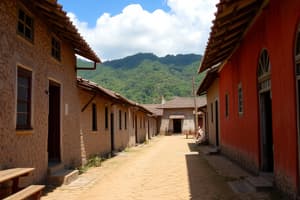Podcast
Questions and Answers
The Cordillera Administrative Region covers 6 provinces including ______.
The Cordillera Administrative Region covers 6 provinces including ______.
Abra
The regional center of the Cordillera is the highly urbanized City of ______.
The regional center of the Cordillera is the highly urbanized City of ______.
Baguio
Kalinga is known for its excellent ______ and basketry.
Kalinga is known for its excellent ______ and basketry.
weavers
Ifugao means 'people from the ______.'
Ifugao means 'people from the ______.'
The artistic expressions of the Igorots are often related to ______.
The artistic expressions of the Igorots are often related to ______.
Weaving is considered an exclusive task for ______ in Ifugao.
Weaving is considered an exclusive task for ______ in Ifugao.
Mountain Province is known for hanging ______ and mummified bodies.
Mountain Province is known for hanging ______ and mummified bodies.
The dominant color of the woven loincloths in Ifugao is ______.
The dominant color of the woven loincloths in Ifugao is ______.
Iloco or Inabel fabric is a hand woven cloth made from ______
Iloco or Inabel fabric is a hand woven cloth made from ______
The process of beating cotton balls using bamboo sticks is called ______
The process of beating cotton balls using bamboo sticks is called ______
Sagut is a natural dye made from the sap of ______
Sagut is a natural dye made from the sap of ______
The weaving tradition of the Ilocanos is known as ______
The weaving tradition of the Ilocanos is known as ______
Banig is a traditional art form made from buri, pandanus, or ______ leaves
Banig is a traditional art form made from buri, pandanus, or ______ leaves
The Cordillera Administrative Region (CAR) is located in the ______-central section of Luzon
The Cordillera Administrative Region (CAR) is located in the ______-central section of Luzon
Study Notes
Iloco or Inabel Fabric
- Handwoven cloth from cotton, significant in the Ilocos region, Philippines.
- Undergoes a traditional beating process called binatbatan, using bamboo sticks to separate seeds.
Binatbatan Process
- Initial stage of cotton processing involving beating cotton balls to extract seeds.
Sagut Dye
- Natural dye sourced from the sap of black plum tree, prevalent in Mangaldan, Pangasinan.
Panagabel Tradition
- Weaving tradition of the Ilocanos, passed down from ancestors.
- Key material used in loom is tilar (sinulid).
Banig (Buri)
- Traditional art form from Bolinao, Pangasinan, made from buri, pandanus, or sea grass leaves.
- Involves drying, dyeing, cutting, and weaving leaves into mats with intricate geometric patterns.
Cordillera Administrative Region (CAR)
- Encompasses six provinces: Abra, Apayao, Benguet, Ifugao, Kalinga, and Mountain Province.
- The only landlocked region in the Philippines, bordered by Ilocos Region and Cagayan Valley.
- Baguio City serves as the regional center.
Origin of Cordillera
- Named by Spanish Conquistadors, meaning "knotted rope," reflecting the mountainous terrain of northern Luzon.
Arts and Crafts of CAR
- Reflect the cultural heritage of various ethnic groups in the region.
Benguet Province
- Home to diverse groups including Igorots, Tagalogs, Ibalois, Ilocanos, Kankanaey, and Ikalahan.
- Skilled in farming on terraced mountains, leading to artistic expressions like tinalik baskets made from rattan.
Kalinga Province
- Noted for exceptional weaving and basketry, textiles characterized by red stripes and geometric designs using white, yellow, and black fibers.
Ifugao Province
- Known as “people from the hills,” with a culture revolving around rice.
- Famous for woven loincloths called ikat, featuring diamond patterns in white and red on a blue base.
- Weaving is primarily a female task, and basket types vary by function.
Mountain Province
- Recognized for hanging coffins and mummified bodies, showcasing unique burial practices.
- Known for kadangyan burial cloth woven exclusively by grandmothers for wealthy individuals.
- Tattoo art serves as a form of cultural expression, marking rites of passage and social status.
Cultural Significance
- The crafts, textiles, and artistic practices in these regions highlight the rich cultural heritage and agricultural lifestyle of the local communities.
Studying That Suits You
Use AI to generate personalized quizzes and flashcards to suit your learning preferences.
Description
Explore the rich heritage of Iloco fabric and the intricate processes involved in its creation. From the traditional binatbatan method to the use of natural dyes like sagut, this quiz covers the artistry of Ilocano weaving. Learn about the Panagabel tradition and the crafting of buri mats in the Cordillera region.




